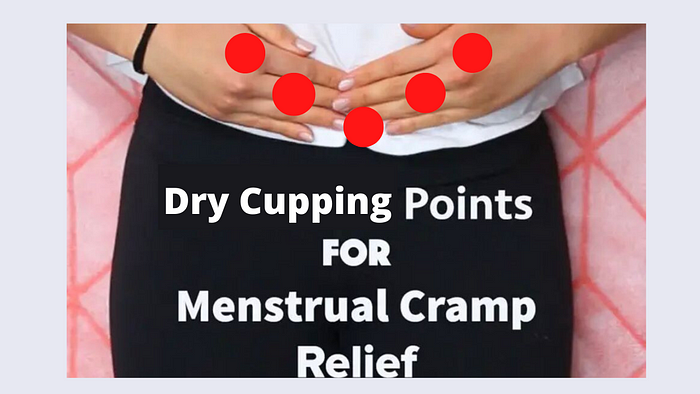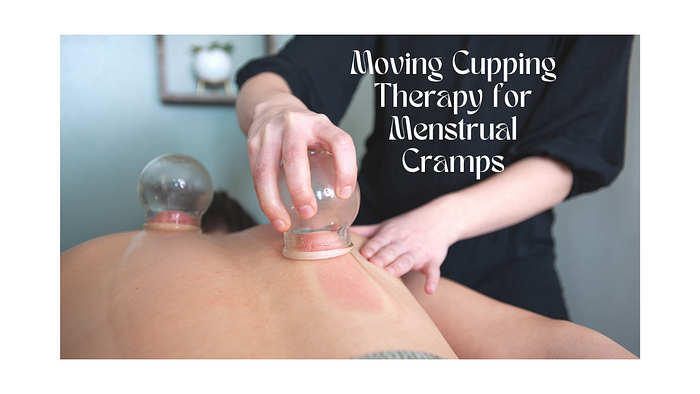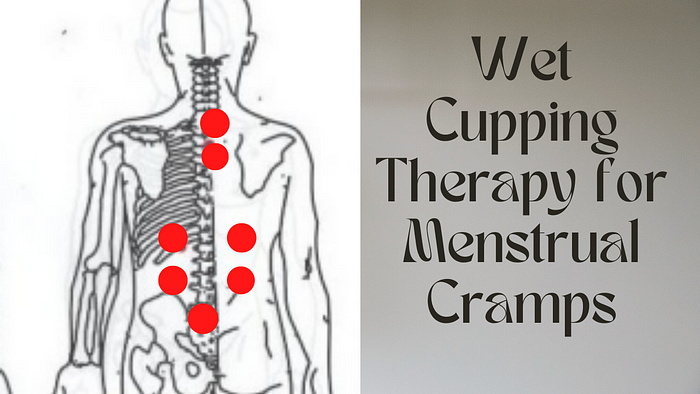What Type Of Cupping Therapy Reduces Menstrual Cramps?
- Get link
- X
- Other Apps
Dysmenorrhea is a medical term for the throbbing and aching cramps in the lower abdomen before and during the menstrual period.
Menstrual cramps can be mild or severe. Some ladies feel mere discomfort during the menstrual cycle and for others, the severe cramps may interfere with their daily routine activities. Severe cramps usually happen for the first time a year or two after a girl first gets her period. The pain becomes less with age.
Types Of Menstrual Cramps
There are two types of menstrual cramps (dysmenorrhea).
Primary menstrual cramps are a very common problem in young women. It is usually defined as cramping pain in the lower abdomen occurring before and during menstruation. These pains are not due to other diseases. This problem is usually underdiagnosed and undertreated. The pain normally lasts 12 to 72 hours, and a woman might have other symptoms of nausea, vomiting, morning sickness or even diarrhea.
2- Secondary Dysmenorrhea
Secondary dysmenorrhea is caused by a disorder or an infection in the female reproductive organs. The pain worsens over time and often lasts longer than normal menstrual cramps.
The Reason - for painful menstrual cramps
Menstrual cramps happen because of contractions in the uterus or womb, which is a muscle. These contractions occur in response to prostaglandins and other chemicals. Cramps get stronger when clots of bloody tissues try to pass the uterus through the cervix, especially if a woman’s cervical canal is narrow. Sometimes contractions are so strong that it presses nearby blood vessels. It briefly cuts off the oxygen to the uterus. The lack of oxygen also causes cramping and pain.
Symptoms
Common symptoms of menstrual cramps are throbbing pain in the abdomen above the pelvic bone. Some other symptoms are as under:
- Nausea, vomiting
- Loose stool or diarrhea
- Sweating
- Dizziness, fainting
- Constipation, bloating
- Pain in the hips, lower back or inner thigh
- Migraines
- Lack of sleep because of discomfort
Risks of Menstrual cramps
Some risk factors that may increase severe menstrual cramps:
- Heavy menstrual bleeding
- A family history of menstrual cramps
- Use of birth control pills
- Depression
- Before the age of 20
- Unhealthy diet
Causes for Menstrual Cramps
Some of the major causes of menstrual cramps are as under:
- In some women, the cervix is not large enough for the blood to flow easily, causing an increase in pressure within the uterus, which is painful.
- A condition called Endometriosis causes menstrual pain and swelling, in which the tissues that act similar to the lining of the uterus grow outside the uterus.
- Another condition is where the lining of the uterus grows into the muscle of the uterus, which causes the uterus to get much bigger than it should be, resulting in heavy bleeding and pain.
- PID is an infection in the female reproductive organs causing pain in the stomach.
- Uterine fibroids, a non-cancerous growth inside, outside or in the walls of the uterus, can also cause menstrual cramps.
Alternate Therapies that might help with Menstrual Cramps
Women with painful menstrual cramps often try to find some natural ways to deal with the horrible pain. Let’s talk about some alternative therapies that might help to reduce the pain of menstrual cramps.
- Massage Therapy: Massage therapy may significantly reduce menstrual pain, especially with a condition called endometriosis. Massage reduces uterine spasms by relaxing the uterus. Massage therapy should be performed on the back and front of the abdominal area to get better results.
- Acupuncture Therapy: This therapy is also considered very effective for the reduction of the intensity of menstrual cramps. Acupuncture also helps to regulate the cycle and lessens the pain by normalizing blood flow.
- Relaxation or Deep Breathing Technique: This technique may reduce menstrual cramps in adolescents because it can relax the body and provide a sense of comfort so that the intensity of pain may gradually disappear. In this therapy, an individual breathes deeply, inhales and exhales air slowly. This therapy reduces pain intensity and anxiety and increases blood oxygenation and peace of mind.
- Cupping Therapy: Cupping therapy dates back thousands of years to Egyptian, Chinese, Middle Eastern, Eastern Europe and Asian cultures. Cupping involves cups to a specific area of the skin in a way that creates suction to restore the flow of blood and energy and stimulates energy. Cupping therapy can be very helpful for women who experience painful cramps before or during their menstrual cycle. This therapy has a positive effect on menstrual cramps, especially around the uterus, lower back and thighs.
Types of Cupping Therapy
Different kinds of cupping affect differently to reduce the pain of menstrual cramps. Let's discuss them one by one.
Dry Cupping
Since ancient times, dry cupping is a very popular method for the treatment of several diseases. In dry cupping, the cups are kept still across the skin to loosen muscles and increase blood circulation and oxygenation in the tissues. Dry cupping therapy is a form of deep tissue therapy. When the vacuum is created inside the cup using suction, it draws the skin and layers of muscles into the cup which allows it to break up the muscles' knots. It also opens pores in the area and cleans the toxins that are built up in the environment.
A study was conducted from May 2009 to July 2010 on 25 patients at The National Institute of Unani Medicine, Banglore. Patients suffering from menstrual cramps with regular cycles, age group 12–37 were selected. For dry cupping 2 glass cups of medium size were applied below the umbilicus for 15 minutes on day 1 or day 2 of the menstrual cycle and pain intensity was assessed by Visual Analogue scale score for pain before and after the treatment. The results were amazing in that dry cupping helped to reduce the intensity of menstrual pain.

Moving Cupping
Moving Cupping Therapy is a form of massage therapy which decompresses soft tissues using vacuum suction. In moving cupping therapy, the cups are applied to the targetted area of the skin in a way that gently creates suction. Oil or any moisturizer is applied to the skin, and then gentle pressure is created so that the cups can glide across the skin. As moving cupping therapy proceeds, the cups are glided toward lymph glands as a way of helping your body expel toxins and waste through lymphatic drainage. Moving cupping therapy is considered very useful for the treatment of digestion, congestion, Inflammation, and bloating, and it also releases the cramps of menstruation. During the session, the moving cupping therapy can cause mild discomfort, similar to massage therapy. The sensation that is experienced in moving cupping therapy is like someone pulling your skin as the cup is moved in a rolling motion. Redness or the feeling of warmth is experienced after the release of the cup due to the increased blood flow that enhances oxygen-rich blood and fresh nutrients.

Wet/Hijama Cupping Therapy
The first step of wet cupping therapy is to apply cups to a specific area of the skin, just like dry cupping therapy. The suction is created inside the cup to lift the skin; after that, small incisions are performed on the cupped area that helps to draw out the toxic and stagnated blood.
While the cups are on the skin, it loosens the muscles and lifts the connective tissues, which increases blood circulation and lymph flow. Hijama cupping therapy gives our body an extra boost to clean the toxic waste.
Hijama cupping therapy brings a very positive impact on menstrual cramps. These pains are most likely caused by an excess of the hormone-like compound — prostaglandins that help the uterus to contract and relax. These contractions cause pain in the uterus. Higher levels of prostaglandins are associated with severe menstrual cramps. Its production is also related to inflammation. Hijama cupping therapy increases blood circulation and reduces prostaglandins and lessens menstrual cramps. Hijama cupping therapy also lessens the inflammation in the body which may cause major diseases.

How to Relieve Menstrual Cramps Naturally
It is not easy to deal with menstrual cramps every month and no one likes to take medicines. Simple home remedies are the best way to get rid of these severe pains.
- Massage your lower back and abdomen with oil.
- A heating pad may help to relax muscles, improve blood flow and relieve pain.
- During the menstrual cycle, the body becomes frail, so taking a nutritional diet is very necessary. Omega-3, magnesium, and vitamins A, E, and Vitamin D may help the body to reduce inflammation which might even make periods less painful.
- According to a study in 2018, aerobic exercise with low intensity may help reduce menstrual cramps.
- Taking a warm bath with Epsom salt and a few essential oils like lavender or rosemary oil may also aid painful periods.
- Stress impacts the hormonal pathway in the body which affects the menstrual cycle too. Try to use stress-relieving techniques like meditation, deep breathing exercises, yoga and Hijama cupping therapy.
- Quit smoking because women who smoke have an increased risk of experiencing painful menstrual cramps.
- Drinking hot water may increase blood flow throughout the body and relax the muscles which help to lessen the cramps.
- It is a good idea to limit foods that cause water retention, bloating and discomfort like salty foods, caffeinated drinks, and fatty or processed foods.
- Certain herbal teas such as chamomile tea, peppermint tea and ginger tea may help to relieve menstrual pain because tea calms the body down.
- Getting adequate sleep promotes overall health and manages pain associated with the menstrual cycle.
Menstrual cramps don’t cause other health complications but they may interfere with our regular and social activities. These cramps are often associated with discomfort. An individual may find relief from self-care techniques and different alternate therapies like Hijama cupping therapy. From my point of view, wet cupping therapy has the most positive effect on menstrual cramps. There is no doubt that dry cupping therapy and moving cupping therapy also have several benefits.
- Get link
- X
- Other Apps


Comments
Post a Comment